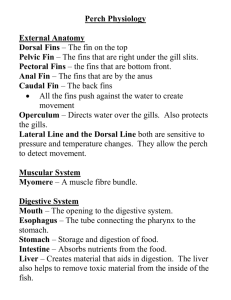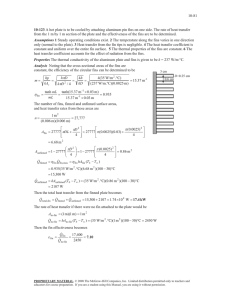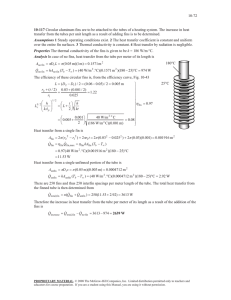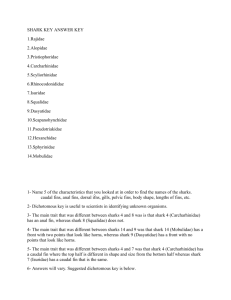Enhancement of Efficiency of Water Heater by providing fins-A Review
advertisement
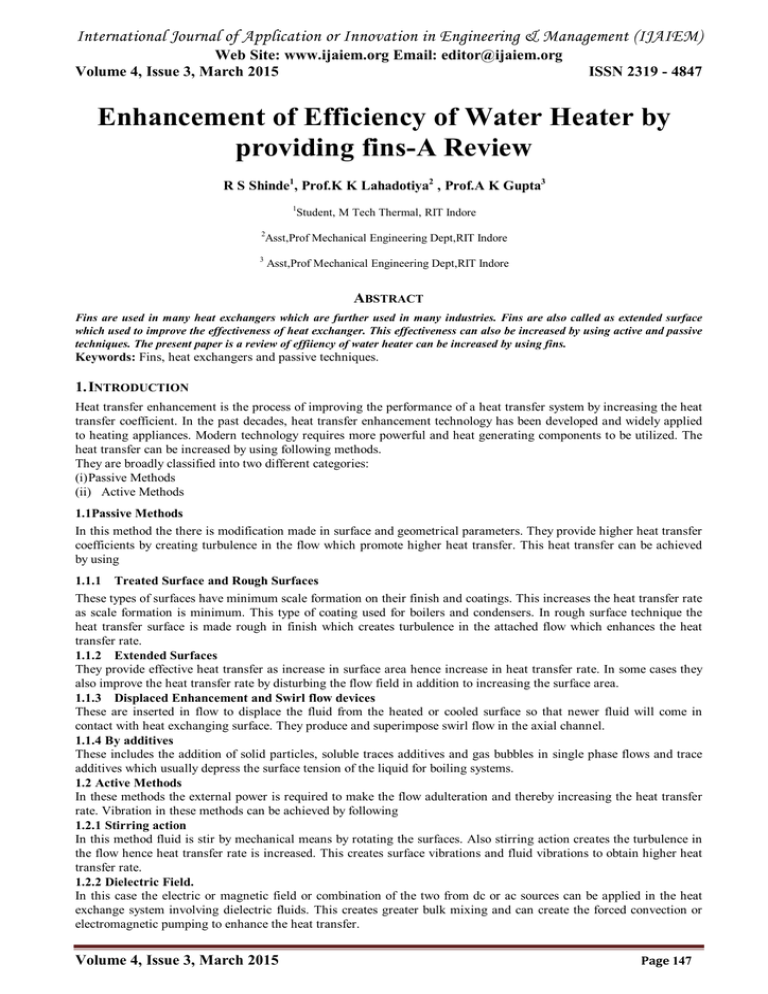
International Journal of Application or Innovation in Engineering & Management (IJAIEM) Web Site: www.ijaiem.org Email: editor@ijaiem.org Volume 4, Issue 3, March 2015 ISSN 2319 - 4847 Enhancement of Efficiency of Water Heater by providing fins-A Review R S Shinde1, Prof.K K Lahadotiya2 , Prof.A K Gupta3 1 Student, M Tech Thermal, RIT Indore 2 Asst,Prof Mechanical Engineering Dept,RIT Indore 3 Asst,Prof Mechanical Engineering Dept,RIT Indore ABSTRACT Fins are used in many heat exchangers which are further used in many industries. Fins are also called as extended surface which used to improve the effectiveness of heat exchanger. This effectiveness can also be increased by using active and passive techniques. The present paper is a review of effiiency of water heater can be increased by using fins. Keywords: Fins, heat exchangers and passive techniques. 1. INTRODUCTION Heat transfer enhancement is the process of improving the performance of a heat transfer system by increasing the heat transfer coefficient. In the past decades, heat transfer enhancement technology has been developed and widely applied to heating appliances. Modern technology requires more powerful and heat generating components to be utilized. The heat transfer can be increased by using following methods. They are broadly classified into two different categories: (i) Passive Methods (ii) Active Methods 1.1Passive Methods In this method the there is modification made in surface and geometrical parameters. They provide higher heat transfer coefficients by creating turbulence in the flow which promote higher heat transfer. This heat transfer can be achieved by using 1.1.1 Treated Surface and Rough Surfaces These types of surfaces have minimum scale formation on their finish and coatings. This increases the heat transfer rate as scale formation is minimum. This type of coating used for boilers and condensers. In rough surface technique the heat transfer surface is made rough in finish which creates turbulence in the attached flow which enhances the heat transfer rate. 1.1.2 Extended Surfaces They provide effective heat transfer as increase in surface area hence increase in heat transfer rate. In some cases they also improve the heat transfer rate by disturbing the flow field in addition to increasing the surface area. 1.1.3 Displaced Enhancement and Swirl flow devices These are inserted in flow to displace the fluid from the heated or cooled surface so that newer fluid will come in contact with heat exchanging surface. They produce and superimpose swirl flow in the axial channel. 1.1.4 By additives These includes the addition of solid particles, soluble traces additives and gas bubbles in single phase flows and trace additives which usually depress the surface tension of the liquid for boiling systems. 1.2 Active Methods In these methods the external power is required to make the flow adulteration and thereby increasing the heat transfer rate. Vibration in these methods can be achieved by following 1.2.1 Stirring action In this method fluid is stir by mechanical means by rotating the surfaces. Also stirring action creates the turbulence in the flow hence heat transfer rate is increased. This creates surface vibrations and fluid vibrations to obtain higher heat transfer rate. 1.2.2 Dielectric Field. In this case the electric or magnetic field or combination of the two from dc or ac sources can be applied in the heat exchange system involving dielectric fluids. This creates greater bulk mixing and can create the forced convection or electromagnetic pumping to enhance the heat transfer. Volume 4, Issue 3, March 2015 Page 147 International Journal of Application or Innovation in Engineering & Management (IJAIEM) Web Site: www.ijaiem.org Email: editor@ijaiem.org Volume 4, Issue 3, March 2015 ISSN 2319 - 4847 1.2.3 Injection and Suction In this technique the single phase flow is injected with the same or a different fluid into the main bulk fluid either through a porous heat transfer interface or upstream of the heat transfer section. In suction technique vapor is removed through a porous heated surface in nucleate and film boiling ,or fluid withdrawal through a porous heated surface in single-phase flow. 2 EXTENDED SURFACES (FINS) Fins or extended surfaces are widely used to augment the rate of heat transfer from primary surface to the ambient medium in a large variety of thermal equipment. An accurate analysis of heat transfer in fins has become crucial with the growing demand of high performance of heat transfer surfaces with progressively smaller weights, volumes, initial and running cost of the system. Over the years different fin shapes have been evolved depending upon application and geometry of the primary surface. The three main fin geometries are longitudinal fins, radial or circumferential fins and pin fins or spines. For any of the above geometry, fins with straight profile or constant thickness are a common choice as they can be manufactured easily. The thermal design of a constant thickness fin is also relatively simple. However, in any fin the temperature difference reduces from the fin base to fin tip. Accordingly, a saving of fin material can be obtained by progressively narrowing down the fin section. This has initiated a lot of exercises for the determination of optimum fin shapes so that the fin volume is minimum for a given rate of heat dissipation or the rate of heat dissipation is maximum for a given fin volume. 2.1 Types of Fins 1) Straight Fins 2) Tapered Fins 3) Circular Fins Straight fins are the extended surfaces which is perpendicular to the base surface having square cross section.These are having same geometrical dimension as that of base surface. Tapered fins are the surface having varying cross section, taper is given to the fins. Taper is in such a way that it is having larger cross section at the base which increases the heat transfer rate at bottom of the fin. Circular fins are mounted on the circular part like pipe, vessel carrying hot fluid having same geometrical shape as that of base surface. Straight fin Tapered fin Circular fin Figure 1.Types of Extended Surfaces Pin fin A.E.Bergles, in a handbook of Heat Transfer Applications, has given a importance of extended surfaces (fins) in technique to augment heat transfer. The removal of excessive heat from system components is essential to avoid the damaging effects of burning or overheating. Therefore, the enhancement of heat transfer is an important subject of thermal engineering. The heat transfer from surfaces may in general be enhanced by increasing the heat transfer coefficient between a surface and its surroundings, by increasing the heat transfer area of the surface, or by both. In most cases, the area of heat transfer is increased by utilizing extended surfaces in the form of fins attached to walls and surfaces. Tieying Ren (1998) discovered that the shear-peel bond strengths and the fluoride release of four orthodontie adhesives. The adhesive groups included a composite resin control, a resin-modified glass ionomer cernent, and two polyacid-modified composite resins (Assure and Experimental). Metal brackets were bonded to the buccal surfaces of 240 (six groups of n = 40) human premolars. The bonded teeth were stored in deionizer water at 37°C for 30 days and thermo cycled for 24 hours prior to debonding. Sample disks, 10 mm diameter by 2 mm thick, were made from each adhesive and stored in deionizer water Volume 4, Issue 3, March 2015 Page 148 International Journal of Application or Innovation in Engineering & Management (IJAIEM) Web Site: www.ijaiem.org Email: editor@ijaiem.org Volume 4, Issue 3, March 2015 ISSN 2319 - 4847 Piotr Wais (Poland) (2001) investigated that in order to intensify heat transfer from the heat exchanger surface to fluid, it is possible to increase convection coefficient (by growing the fluid velocity), widen temperature difference between surface and fluid or increase the surface area across which convection occurs. Extended surfaces in the form of longitudinal or radial fins are common in applications where the need to enhance the heat transfer between a surface and an adjacent fluid exists. Bayram Sahin and Alparslan Demir (2008) gives the performance analysis of a heat exchanger having perforated square fins. Extended surfaces (fins) are frequently used in heat exchanging devices for the purpose of increasing the heat transfer between a primary surface and the surrounding fluid. Various types of heat exchanger fins, ranging from relatively simple shapes, such as rectangular, square, cylindrical, annular, tapered, or pin fins, to a combination of different geometries, have been used. Bayram Sahin and Alparslan Demir (2008) worked on design of modern thermal systems, to design more compact and efficient heat exchangers. Reducing energy loss due to ineffective use and enhancement of energy transfer in the form of heat has become an increasingly important duty for the design engineers of thermal systems, considering the world wide increase in energy demand. This duty requires employing heat transfer surfaces with high heat transfer coefficients and high area compactness. Particular attention in the selection/design of heat transfer surfaces is required if the energy carrying fluid selected is a gas Abdullah H. AlEssa and Mohammed Q. Al-Odat (2009) proved that the removal of excessive heat from system components is essential to avoid the damaging effects of burning or overheating. Therefore, the enhancement of heat transfer is an important subject of thermal engineering. The heat transfer from surfaces may in general be enhanced by increasing the heat transfer coefficient between a surface and its surroundings, by increasing the heat transfer area of the surface, or by both. In most cases, the area of heat transfer is increased by utilizing extended surfaces in the form of fins attached to walls and surfaces. Extended surfaces (fins) are frequently used in heat exchanging devices for the purpose of increasing the heat transfer between a primary surface and the surrounding fluid. Narayan K. Sane and Sanjeev D. Suryawanshi (2009) discovered that the fin spacing, heater input and percentage of area removed in the form of inverted notch are the parameters for enhancement of heat transfer coefficient. For few spacing, it is verified by computational fluid dynamics analysis and the results are well matching. It is found that the average heat transfer coefficient for INFAs is nearly 30– 40% higher as compared with normal array. Sepehr Sanaye and Hassan Hajabdollahi(2010) presented the Thermal modeling and optimal design of compact heat exchangers in this paper. NTU method was applied to estimate the heat exchanger pressure drop and effectiveness. Fin pitch, fin height, fin offset length, cold stream flow length, non-flow length and hot stream flow length were considered as six design parameters. V.K. Patel and R.V. Rao (2010) developed non-traditional optimization technique for the Heat exchanger design which involves complex processes, including selection of geometrical parameters and operating parameters. The traditional design approach for shell and- tube heat exchangers involves rating a large number of different exchanger geometries to identify those that satisfy a given heat duty and a set of geometric and operational constraints. However, this approach is time-consuming and does not assure an optimal solution. Hence the present study explores the use of a non-traditional optimization technique; called particle swarm optimization (PSO), for design optimization of shell-andtube heat exchangers from economic view point. Minimization of total annual cost is considered as an objective function. Jan Taler (2010) discovered that the fin and tube geometry affects the flow direction and has the effect on the temperature changes. Numerical analysis is carried out to examine finned tube heat exchanger. Three dimensional models are performed to find heat transfer characteristics between a finned tube and the air. M. R. Chopade (2011) proved engineering significance of heat sinks in the form of fin arrays on horizontal and vertical surfaces used in variety of engineering applications, studies of heat transfer and fluid flow associated with such arrays. The main controlling variable generally available to designer is geometry of fin arrays. V. N. Kapatkar (2011) worked on experimental analysis of the results obtained over a range of fin heights and heat dissipation rate. Attempts are made to establish a comparison between the experimental results and results obtained by using CFD software. V.M.KRIPLANI (2011) proposed that the extended surface heat exchangers are simple in construction and extensively used in many industries. Continuous Research is going on to improve its effectiveness by increasing fluid turbulence, generating secondary fluid flow patterns, reducing the thermal boundary layer thickness and increasing the heat transfer surface area. The present paper is a review of different types of arrangements of extended surfaces. 3 CONLUSION Following important conclusions are drawn from the above review: 1. The efficiency of water heater can be greatly enhanced due to extended surfaces (fins). 2. Required temperature of hot water can be achieved in less time. 3. The amount of energy required for heating the water can be reduced which result in saving of energy. Volume 4, Issue 3, March 2015 Page 149 International Journal of Application or Innovation in Engineering & Management (IJAIEM) Web Site: www.ijaiem.org Email: editor@ijaiem.org Volume 4, Issue 3, March 2015 ISSN 2319 - 4847 4. Cost of energy required for heating of water will also reduced. REFERENCES [1] A.E. Bergles, “Technique to Augment Heat Transfer”, in handbook of heat transfer applications, second edition, ch. 3, eds. Werren M. Rohsenow, James P. Hartnett, and Ejup N. Ganic, NY: McGraw-Hill. [2] Tieying Ren, “An Experimental Study of the Local Mean and Turbulent Flow Field Affecting Forced Convection Heat Transfer for Finned Tubes in Cross Flow”, submitted in partial fulfillment of the requirements for the degree of Master of Engineering Science December, 1998, page no.20-80. [3] Piotr Wais, “Fin-Tube Heat Exchanger Optimization”, Journal of Engineering Research and Studies, Vol.III, 2001, page no.345-360. [4] Bayram Sahin and Alparslan Demir, “Performance Analysis of a Heat Exchanger Having Perforated Square Fins”Applied Thermal Engineering, 6(2008), pp. 621–632. [5] Bayram Sahin and Alparslan Demir, “Thermal Performance Analysis and Optimum Design Parameters of Heat Exchanger Having Perforated Pin Fins”, Energy Conversion and Management, available online 4 January 2008, doi:10.1016/j.enconman. 2007. [6] Abdullah H. AlEssa and Mohammed Q. Al-Odat, “Enhancement of natural convection heat transfer from a fin by triangular perforations of bases parallel and toward its base”, the Arabian Journal for Science and Engineering, Volume 34, Number 2B, May 27, 2009. [7] Narayan K. Sane and Sanjeev D. Suryawanshi, “Natural Convection Heat Transfer From Horizontal Rectangular Inverted Notched Fin Arrays”, Journal of Heat Transfer, August 2009, Vol. 131. AUTHOR Rahul S Shinde received the B.E. degree in Mechanical Engineering from Savitri Bai Phule University( Formerly University Of Pune) in 2007.He is pursuing MTech in Thermal engineering from Rishiraj Institute of Technology(Indore),RGPV Bhopal. Volume 4, Issue 3, March 2015 Page 150

